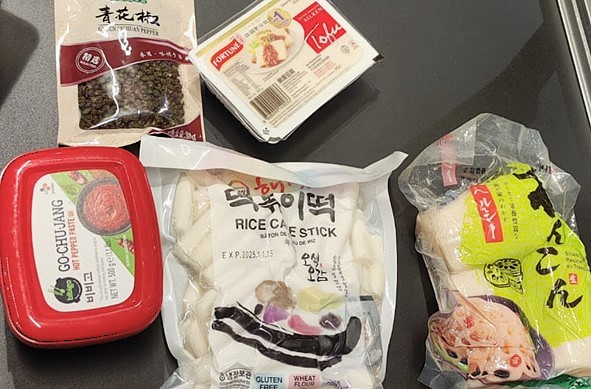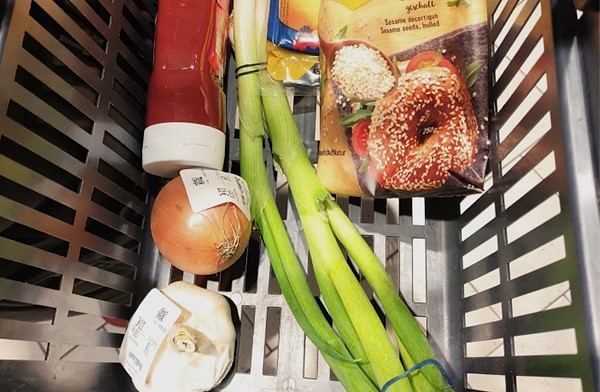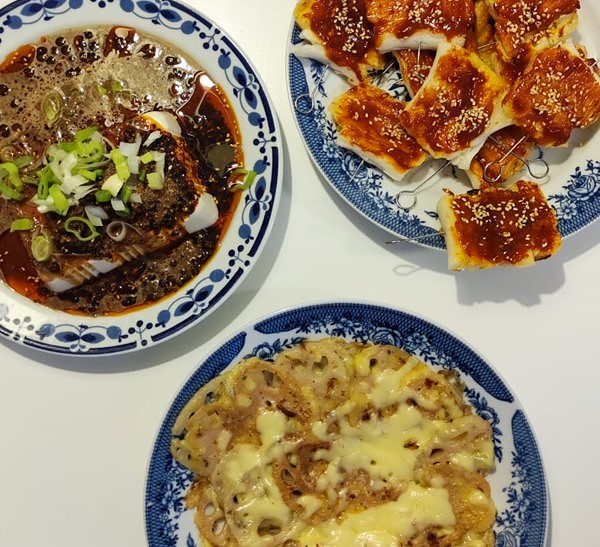by Karo, Myrna and Diana
On a Tuesday evening in November, the three of us decided to cook three different dishes selected from the internet to fulfill one of our assignments for the class “Globalization of East Asian Cuisines”. First, we watched various videos on TikTok and Instagram by looking up the hashtags #chineserecipes, #koreanrecipe, #japaneserecipe, and we scrolled until we found three vegetarian recipes that looked delicious and seemed like small dishes. For the Japanese recipe, we decided to cook a lotus pancake and a rice cake cheese skewer was the winning Korean dish. We found both recipes on TikTok. In addition, we selected a Chinese tofu dish from Instagram. The recipes were easy to follow as the videos we selected included the instructions in the description of the post or in the video itself. All recipes were described by the authors as quick and easy to prepare with few ingredients.
The recipe for the lotus pancake was posted by @ayaka_hakko on TikTok. It is a Japanese account and all the posts seem to be related to Japanese food. The account is very popular with more than 30k followers. The comments under the posts are all in Japanese and most praise how easy and good the dish looks. The recipe for the rice cake skewer was posted by @bamboooyah on TikTok. The account mainly features Korean food, both home-cooked and restaurant dishes, and has around 225k followers. The comments are mostly in English and focus on either asking about the sauce used to coat the skewers or how delicious and crispy they look. The tofu recipe was posted on Instagram by SBS Food, a 24/7 food channel for the Australian public that focuses on simple, authentic and everyday food inspiration from different cultures. The account has 328k followers on Instagram. The comments under the posts are all in English and sometimes only contain emojis. Some comments either tag people or say that it looks delicious.

Copyright © Myrna G. 2025
Our mission was to try and see if it was possible to replicate these authentic recipes in Berlin. And the outcome was very positive since we were able to find all of the ingredients at either a supermarket or an Asian grocery store. But before we went to any stores, we checked what we already had at home. In the end, we only had to get some onions, garlic, cheese, sesame and scallions from the supermarket, and Szechuan peppercorns, gochujang, tofu, lotus root and rice cakes from the Asian grocery store. We were able to find all the ingredients, but encountered some problems with the lotus root. Initially, we wanted to buy fresh lotus root, but had to buy some pre-peeled, packaged lotus root instead. Our total bill for the food was 30€, including some additional costs for drinks.

Copyright © Myrna G. 2025
The next step was to prepare all the ingredients and cook them. Two people prepared the ingredients by cutting the lotus root, peeling and slicing the garlic, dicing the cheese and defrosting the rice cakes, while one person weighed the ingredients such as sesame seeds or measured out all the liquid ingredients. All three dishes required some cooking, so we started by preparing the three sauces for the Chinese tofu dish. For the sesame sauce, we had to roast sesame seeds, heat some neutral oil for the chili oil and sauté garlic with soy sauce and sugar for the garlic jam. Once we had drained the tofu and prepared the three types of sauce, we were able to plate this first dish. The second dish we prepared was the lotus pancakes. The freshly cut lotus root was tossed in a mixture of garlic, onions and potato starch and seasoned with a little salt and pepper. After heating some oil in a pan, half of this mixture was added to the pan in slices and topped with some cheese. The second half of the lotus root was then carefully placed on top, and once the cheese had melted the two layers together, we flipped the pancake, which was surprisingly more difficult than it sounds. We sprinkled the pancake with the remaining cheese and fried it for a few more minutes until we were ready to plate this dish as well. For our final dish, the Korean cheese and rice cake skewers, we took the defrosted rice cakes and cheese, which we had cut into similar sized pieces, and skewered them onto metal skewers, also known as roulade pins. These skewers were then placed in a medium-hot pan and turned over once the cheese was crispy. Before serving, we coated the fried skewers with a spicy chili ketchup sauce and garnished them with some leftover roasted sesame seeds.

Copyright © Diana N. 2025
In general, cooking Asian dishes is a great way to connect with Asian culture, overcome cultural differences and learn more about each other. Berlin as a multicultural city encourages people to engage with each other in a variety of ways. For this experiment, we found that cooking East Asian dishes here in Berlin is a great way to engage with other cultures in a respectful way. Gathering the ingredients was relatively simple and straightforward, and thanks to the detailed descriptions on social media, it was also easy to follow the cooking instructions. With globalization affecting all areas of our daily lives, it is only natural to look into the globalization of East Asian food and our consumption of East Asian products and lifestyles. Social media makes this very easy. For those interested, we have linked the original recipe videos so you can try for yourself how easy it is to cook authentic East Asian dishes in your hometown. Have fun cooking!
References:
Japanese Lotus pancake: https://vm.tiktok.com/ZNe3WE7SL/
Korean Cheese-Ricecake skewers: https://vm.tiktok.com/ZNe37d8XD/
Chinese three sauce tofu: https://www.instagram.com/tv/CiJWoObJxef/?igsh=dDhhaW90cjdhcnly
Karo, Myrna and Diana are students in the Master program Global East Asia at Freie Universität Berlin.
